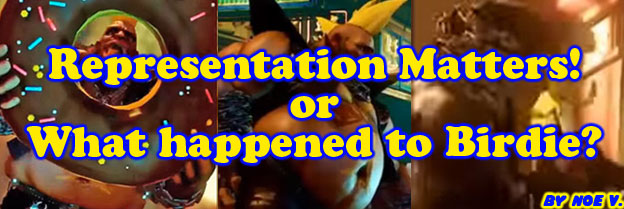
The characters in fighting games are rarely based on mythological figures. Instead they are based on real fighters, comic book characters or actors. Fat martial artists are few and far between. The most popular and longest-lived template for fat fighters is Sammo Hung. The writer, director and actor from Hong Kong broke into cinema at a young age. His talents behind the camera are nothing compared to his knowledge and experience in the martial arts. He was trained as a child in the Chinese Drama Academy, where performers learned what it took to appear in the Chinese Opera. He learned various forms of kung-fu as well as tumbling and working with weapons. The lessons were brutally difficult, children were made to do handstands and splits for hours on end, they would be disciplined with caning for being disobedient. Many would consider the training to be nothing short of child abuse. Sammo made it through and became an exceptional performer and choreographer. He was developed alongside people like Jackie Chan and Yuen Biao, whom also became martial arts superstars. There was a dramatized retelling of what they had gone through in the film Painted Faces. Sammo actually played an instructor in the film and said many things that happened to him growing up were much harsher than what the film depicted.
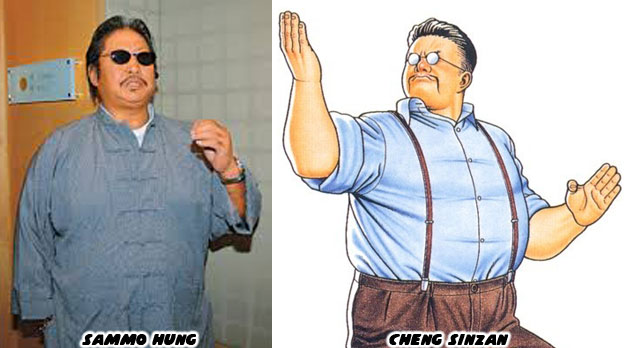
The first fighting game to feature a character modeled after Sammo was Fatal Fury 2 in 1992. Cheng Sinzan was a businessman and expert martial artist. He was fast, as Sammo was, had an assortment of great kung-fu attacks but was always played up to be slightly funny. Sammo was known for his comedic timing. As great as he was in a fighting scene he always found a way to get in a visual gag, usually at the expense of his weight. It was no different for Cheng. He sweated profusely and could be seen wiping his forehead with a handkerchief in between rounds. Cheng got fatter when he turned up again as a non-playable cameo in Fatal Fury 3 and then as a playable character in Real Bout Special. Each time he came back he was fatter than the last time.
The same trend happened to other fat characters in fighting games. They became extraordinarily large, more so than average people. Sammo was always what we would consider "chubby" but he was nowhere near as fat as the in game versions of Cheng were. This was something that character designers and animators learned to do as the genre evolved. It did not matter what form of fighting that a character practiced. They had to have very exaggerated proportions. This was something that worked well in comic books and manga. Gamers would be less likely to watch two average-looking people in a fight, on television or in the comics. If instead the karate guy had torn sleeves to show off bodybuilder-like biceps and the female kung-fu expert had a short dress to show off her long shapely legs then it would be much more appealing.
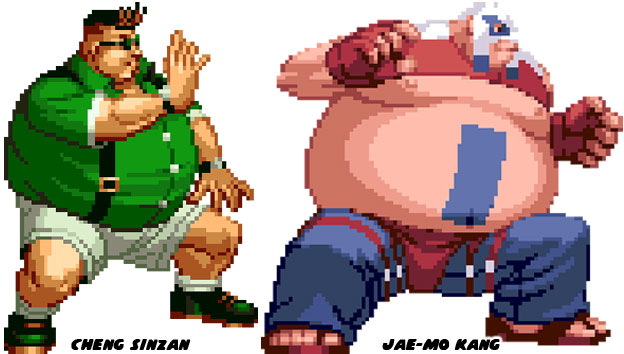
By the same process the fat characters could not be slightly overweight in games or comics, the had to be morbidly obese. Cheng was only the tip of the iceberg. As other studios got into the genre they began pushing the envelope on what was possible. Those with muscles became extraordinarily swollen, female characters became bustier, and fat characters became almost perfectly round. Such was the case with Jae-Mo Kang, the Korean pro wrestler from the 2002 game Rage of Dragons. The game was set in an anime-like version of the Double Dragon universe. The developers at Evoga avoided the continuity from the previous Double Dragon fighting game. Kang was strong but not meant to be taken as seriously as Burnov.
Fat characters were beginning to find their stride through the late '90s and into the '00s and they were supposed to be funny. Any great elements that Sammo had given his roles, anything he meant to the martial arts was completely lost. Heaven help the player if they actually liked or even identified with the fat characters. They were not meant to be seen as stars of the games. In 1994 SNK launched the King of Fighters series. It would become the longest-lived and most popular tag team fighting franchise. The Taekwondo star of the game, Kim Kaphwan needed two partners to round out the Korean team. The designs given to his partners were lackluster. One was a short criminal, Choi Bounge, with claw gloves and a fedora. He looked like a tiny Freddy Krueger from the Nightmare on Elm Street movies. The other was a tall but obese criminal named Chang Koehan. Kim was trying to rehabilitate the pair. Chang was oafish, swinging and enormous ball and chain at his opponents. He lacked appeal and would appear on and off with the team.
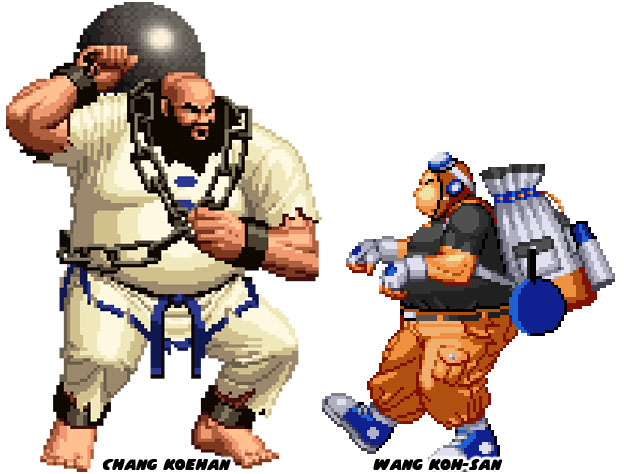
Taking a page from the Cheng Sinzan school of funny fatties was Wang Koh-San. The chubby character was introduced in the Art of Fighting 3. The character was a cartoonist that was in the tournament. He seemed outfitted for a long time on the road with all sorts of camping gear attached to his backpack. In the sack there was a pelican that would pop up from time to time. Not only was the character fat and funny but he even had a wacky bird sidekick. If this was a Hanna Barbera cartoon from the '70s then it would have been a hit. In fighting games players were just left scratching their heads.
SNK had started a tradition of having morbidly obese people serve as comic relief as far back as 1993. Earthquake in the game Samurai Spirits / Showdown was an American ninja. He was massive, at the time being one of the largest sprites ever created for a fighting game. The character took up almost a third of the screen. He was fat and gross too. Farting on opponents and eating turkey legs that he kept stashed away in his belt. Yet despite these things he was a very fresh design. He had tattoos, and face paint, he was colorful and brought attention to himself. This was the opposite of what most people thought of when they heard that he was a ninja. Despite his size he was able to move quickly, disappear in a puff of smoke and fight with some unique attacks. Earthquake was meant to represent greed, he wanted everything in excess and was looking for the fastest way to get rich, which was why he was so big and fat. He was actually balanced out by another American ninja named Galford. Galford had stayed on the true path set by his masters and was therefor young and handsome. Despite his gross aspects there was not another obese character that was as memorable as Earthquake.
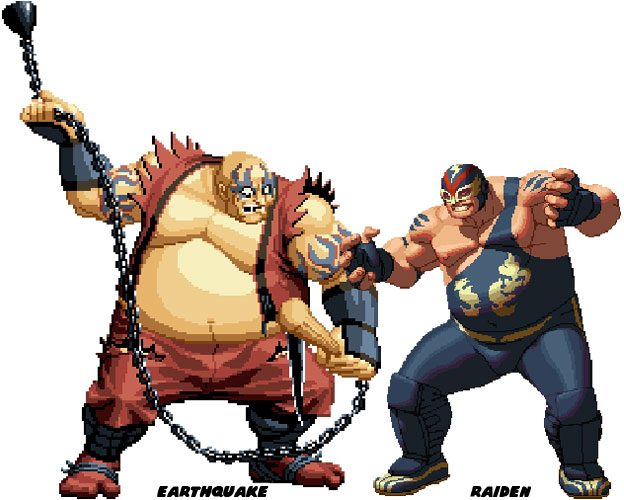
Other studios followed the trend and would only pull out the fat character if they could get a joke out of it. This reality came to a head in 2006 with the release of Tekken 6. The Tekken series was one of the fighting games that actually kept pace with the Street Fighter in terms of sales and popularity. It set itself apart from the other titles because it was one of the first 3D fighting games. The designers of that series and head producer Katsuhiro Harada had introduced dozens of characters into continuity. Many were from around the world and there was even a diverse mix of female characters as well. The game had always combined the fantastic as well as science fiction, cyborgs, mutants angels and demons were all within canon. The reality it was based in was only loosely grounded and this was the understanding that audiences were expected to accept when Bob was put in the game. Bob was a great fighter but he felt that it took too much effort to defeat opponents. He decided that he could do better in tournaments if he had some extra weight behind his punches and kicks. He bulked up and became about three times as heavy as he used to be.
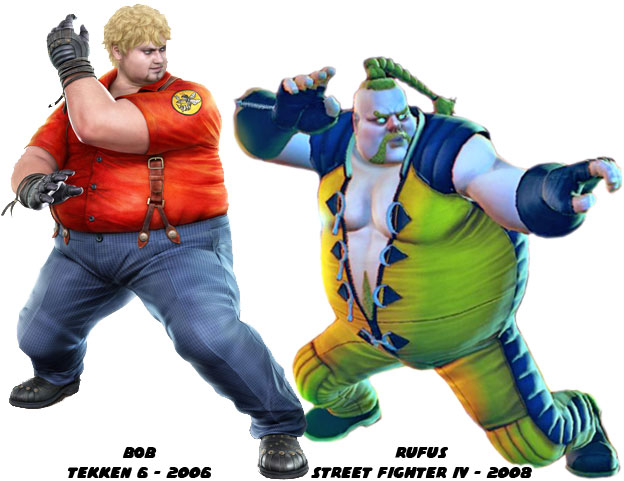
It was strange watching Bob in the game, not because of his size but because how fast he moved. Despite his girth the character was blindingly fast. But that speed also made him look weightless. The graphics engine was very powerful. It was capable of rendering flowing hair, accurate shadows and reflections as well as clothes that bunched and folded realistically. It even put a little bit of jiggle in Bob's belly fat. The illusion of a three-dimensional figure was broken each time he attacked. Bob was so fast that he simply appeared unrealistic.
Yoshinori Ono must have had a strong reaction to Bob because a few years later he announced a new character to debut in Street Fighter IV. Many game players were hoping for something as unique and memorable as the figures in Street Fighter EX, Street Fighter Zero and Street Fighter III. The new character was memorable but for all the wrong reasons. Rufus took a page from Bob and the developers went even faster with his moves and attacks. His gigantic belly would sway underneath his jumpsuit. Both Harada and Ono had put a fat character in the game because it was funny. They did not mean to be more inclusive of different body types. I mean could you imagine how absurd it would be to see a serious fat person in a game? Fat people were not heroes, they were social outcasts. It was obvious in public and reinforced in media.
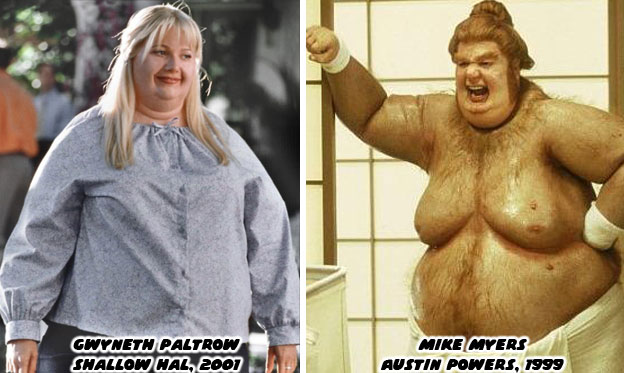
Makeup artists had been making people appear fat since the days of black and white movies. But when newer techniques allowed them to create lightweight "fat suits" then Hollywood began looking for ways to exploit the technology. Comedians Eddie Murphy and Martin Lawrence used fat suits in films to lampoon fat stereotypes respectively in the Nutty Professor and in Big Mama's House. Mike Meyers had a recurring character called Fat Bastard from the 1999 film Austin Powers: the Spy Who Shagged Me. The hit man had an unmistakable presence and was meant to be gross and disgusting. But as audiences discovered there was an underlying sadness to the character this gave him much more dimension than simply writing gag after gag on how fat he was. In his final appearance Fat Bastard had lost his weight and had become much happier with himself.
A similar lesson lesson on sympathy and understanding was learned in the Farrelly Bros. Comedy Shallow Hal from 2001. Gwyneth Paltrow played Rosemary Shanahan and she couldn't find a person to accept her for who she was. Jack Black played Hal Larson, a womanizer who gets hypnotized by life coach Tony Robbins into seeing the inner beauty of people instead of the physical ideals of beauty. Hal realizes that Rosemary is the person he'd been looking for all his life. Both films were comedies and both relied on fat as the punchline to many jokes. Characters like Bob and Rufus appeared later and were simply reinforcing that stereotype.
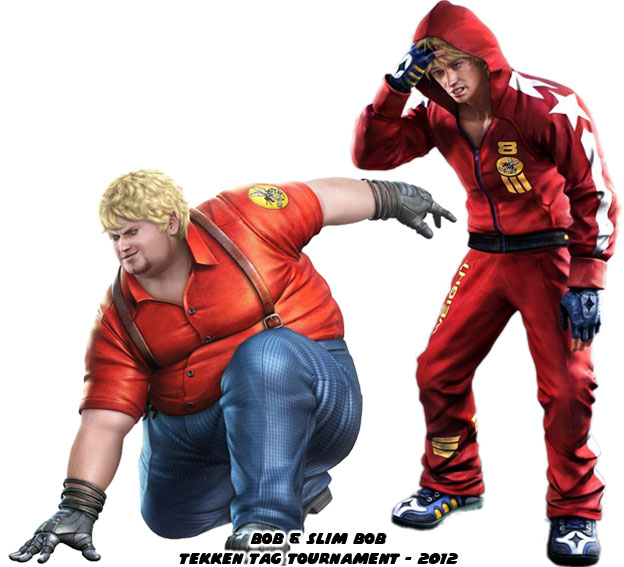
Bob actually had a physical transformation over the years. He lost his weight and by 2012 was back down to his original size. Of course the Tekken team could not allow the character to be quite happy with whatever size he was. Since he had lost the weight it required more effort for him to win battles. He was left tired more often and wondered if his weight loss was worth it. Fat people couldn't catch a break even when they were no longer fat.
What really irks me about the direction of Street Fighter IV and V were how fat was being used as a punchline as well. It was cheap, it was demeaning and it took away from the elements that made all of the other characters great. I've mentioned it before but it bears repeating now more than ever. The designers on Street Fighter IV and V are putting a priority of visual gimmicks and pandering to stereotype rather than great character designs. We could start with Rufus and work backwards. In doing so we could spot a trend. That trend sadly leans towards racial bias and I would even say racial exclusion from Street Fighter.
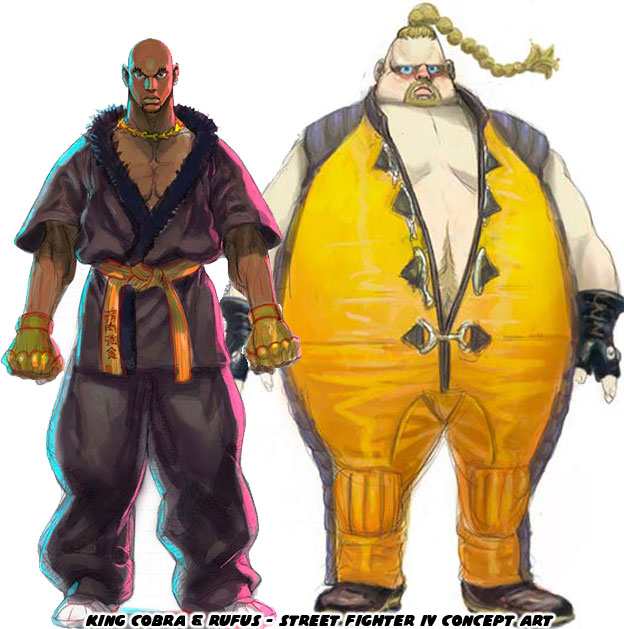
Many people that read my blogs know that the fat white Rufus was not the original choice as a new character in Street Fighter IV. Instead he was going to be a young black man named King Cobra / Black Cobra. The character was in pretty much the final stages when Yoshinori Ono went in a radically different direction and pushed the team to put a "fatty" in the game. All of the great elements of Cobra were gone and in his place there was a tub of jelly that was insanely fast and had moves perfect to counter most every other character in the series. We can actually work backwards and see who Rufus was based on and how radically different he was in the early stages.
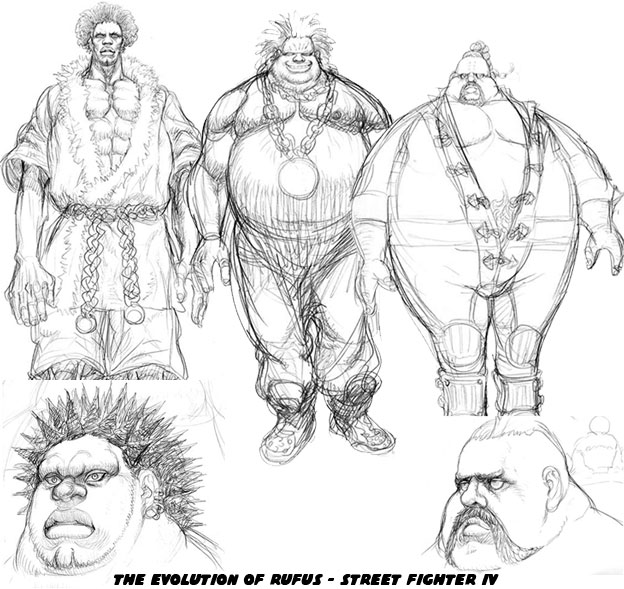
Rufus was meant to be the ultimate rival to Ken. The team realized that Ryu had a great rival with Sagat but after 20 years there was not somebody for Ken. The designers wanted players to see a character that was both physically imposing and could be a genuine threat to Ken. They knew this character had to be bigger-than-life, just like Sagat. They also considered making him a minority similar to Sagat. In the planning stages Rufus was a tall, heavy set black man with subtle gangster features. He had high top sneakers, a thick gold chain and pointy dreads. The fat gimmick got more and more pronounced the closer he came to Yoshinori's vision of a fatty. But if you go back far enough you can actually find a character that met the original plan and wasn't fat or silly at all.
The first thing that made rivalry between Ryu and Sagat important was the size difference between the two characters. Ryu was almost six-feet tall but Sagat was about a foot and a half taller. King Cobra would have been at least as tall if not taller. The earliest version of this figure was tall and lanky. He actually looked like Kareem Abdul Jabbar, the basketball player and friend of Bruce Lee. Kareem played the final opponent in Lee's last film the Game of Death. The second thing that made the classic rivalry important was the techniques that each fighter possessed. Ryu studied karate which was considered a very refined form of self defense and required tremendous self discipline to master. Sagat studied Muay That which was an older system that was designed to hurt, maim and kill opponents. It was an art that required people to be very aggressive and tough. The two styles clashed against each other perfectly. Ken's opponent would have been a tall black man that was a master of a certain form of karate. Perhaps having two forms of karate was a bad choice and the designers began looking elsewhere.
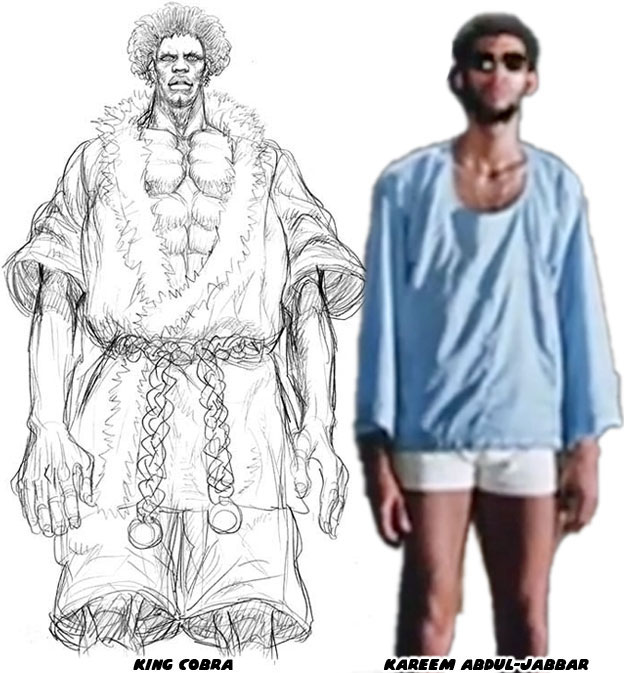
A few of the early US martial arts stars and tournament champions were black. Ron Van Clief, master of karate and several forms of kung-fu was nicknamed "The Black Dragon" and karate champion Jim Kelly starred as the Black Samurai. They were both martial arts pioneers and friends of Bruce Lee. They were well versed in various forms of fighting and this was apparent when they performed on film. What was terrible for the duo was that they could find work in Hong Kong cinema yet be denied many opportunities in the USA. If they performed in a US film they were usually the "Blacksploitation" kind. The two overcame many hardships because of the color of their skin. Things were especially hard for Van Clief. When he joined the Army and was sent to the South to train he was lynched by his fellow enlistees. He barely survived the attack and had to deal with racism both in and out of uniform. Racism was very strong in many parts of the country and that animosity exists to this day.
When I think of a missed opportunity to put in a powerful black karate fighter I think about how blacks had become caricatured in the genre. Just as everything great about Sammo Hung had been stripped away when creating fat characters in the genre. The only thing that Japanese studios seemed to remember from the early black martial arts appearances were the afro and sideburns worn by Clief and Kelly. The developers had reduced black fighters to a trope. It was seen with Tiger Jackson from Tekken, and Mr. Jones from Rage of Dragons. The black fighters in modern games still wore afros, sunglasses and bell bottom pants as if they were perpetually locked in the '70s.
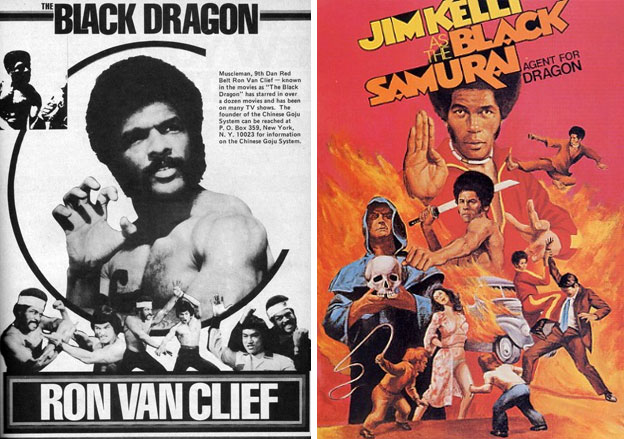
Another questionable approach to the design and purpose of Rufus was how stupid he was. In canon Rufus was incredibly dumb, taking an obvious jab at the Fat Dumb American stereotype. He was so dumb that he could not even identify Ken if they crossed paths, which they did several times. I mean how great it is to have an arch-rival for Ken that is too stupid to spot him in the same room? It's genius planning I tell you! I doubt and sincerely hope that the black rival would not have been presented as stupid.
Imagine what would have happened to Sagat if he couldn't remember what Ryu looked like. His purpose in the series and reputation would have been greatly diminished. Karate could have very well been assigned to Cobra and it could have been a form unique to the Street Fighter universe. But seeing as how the Japanese developers didn't really know much about black fighters then they made things up. In the design notes Cobra actually used "Breakdance Kung-Fu." It seemed as if the Japanese developers could never take blacks seriously as being masters of karate.
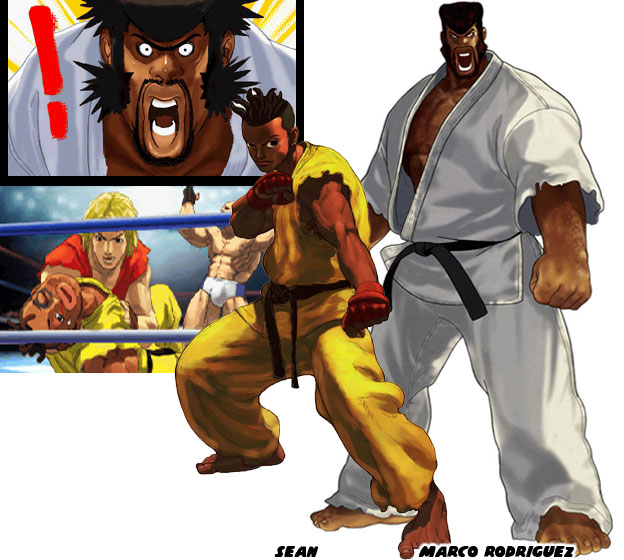
Miscasting a minority was nothing new to Japanese developers. Characters like Sean from Street Fighter III and Marco Rodriqguez from Garou: Mark of the Wolves, while popular, were not meant to be taken seriously. They were not supposed to be stars of the games. Instead they were supposed to be overzealous proponents of the fighting art. They were too enthusiastic for their own good and that lesson was seen in their respective endings. Sean would never become as great as Ken. Marco would never become as great as Ryo Sakazaki. Their roles were subservient, it's quite possible that the designers never thought about the statement they were making through these characters.
The thing about history was that blacks were an important part of the evolution of karate. Karate champions Willie Williams, Jamie Oliver and Charles Martin were the subject of the documentary The Fighting Black Kings, set during the 1st Kyokushin (the form founded by Mas Oyama) World Karate Championship. They were the basis for Marco but they were not the only black fighters that influenced the Japanese designers. But I am getting a bit off of the subject. Fat characters were put into fighting games because they were funny to look at. When presented with a choice as to put a strong black character in Street Fighter or put a fatty in Street Fighter the director chose the latter. This is what drives me insane about the people that worked on Street Fighter IV and the people working on Street Fighter V. Each time they make a design choice for a new character it always seems to be the wrong one. It always seems to degrade the character if not devalue the art being depicted. This was a problem that went all the way back to Street Fighter II, however Capcom was able to overcome some potentially disastrous choices. We will look at these things in the next blog. As always if you enjoyed this blog and would like to sponsor me please visit my Patreon page and consider donating each month, even as little as $1 would help make better blogs and even podcasts!

The first fighting game to feature a character modeled after Sammo was Fatal Fury 2 in 1992. Cheng Sinzan was a businessman and expert martial artist. He was fast, as Sammo was, had an assortment of great kung-fu attacks but was always played up to be slightly funny. Sammo was known for his comedic timing. As great as he was in a fighting scene he always found a way to get in a visual gag, usually at the expense of his weight. It was no different for Cheng. He sweated profusely and could be seen wiping his forehead with a handkerchief in between rounds. Cheng got fatter when he turned up again as a non-playable cameo in Fatal Fury 3 and then as a playable character in Real Bout Special. Each time he came back he was fatter than the last time.
The same trend happened to other fat characters in fighting games. They became extraordinarily large, more so than average people. Sammo was always what we would consider "chubby" but he was nowhere near as fat as the in game versions of Cheng were. This was something that character designers and animators learned to do as the genre evolved. It did not matter what form of fighting that a character practiced. They had to have very exaggerated proportions. This was something that worked well in comic books and manga. Gamers would be less likely to watch two average-looking people in a fight, on television or in the comics. If instead the karate guy had torn sleeves to show off bodybuilder-like biceps and the female kung-fu expert had a short dress to show off her long shapely legs then it would be much more appealing.

By the same process the fat characters could not be slightly overweight in games or comics, the had to be morbidly obese. Cheng was only the tip of the iceberg. As other studios got into the genre they began pushing the envelope on what was possible. Those with muscles became extraordinarily swollen, female characters became bustier, and fat characters became almost perfectly round. Such was the case with Jae-Mo Kang, the Korean pro wrestler from the 2002 game Rage of Dragons. The game was set in an anime-like version of the Double Dragon universe. The developers at Evoga avoided the continuity from the previous Double Dragon fighting game. Kang was strong but not meant to be taken as seriously as Burnov.
Fat characters were beginning to find their stride through the late '90s and into the '00s and they were supposed to be funny. Any great elements that Sammo had given his roles, anything he meant to the martial arts was completely lost. Heaven help the player if they actually liked or even identified with the fat characters. They were not meant to be seen as stars of the games. In 1994 SNK launched the King of Fighters series. It would become the longest-lived and most popular tag team fighting franchise. The Taekwondo star of the game, Kim Kaphwan needed two partners to round out the Korean team. The designs given to his partners were lackluster. One was a short criminal, Choi Bounge, with claw gloves and a fedora. He looked like a tiny Freddy Krueger from the Nightmare on Elm Street movies. The other was a tall but obese criminal named Chang Koehan. Kim was trying to rehabilitate the pair. Chang was oafish, swinging and enormous ball and chain at his opponents. He lacked appeal and would appear on and off with the team.

Taking a page from the Cheng Sinzan school of funny fatties was Wang Koh-San. The chubby character was introduced in the Art of Fighting 3. The character was a cartoonist that was in the tournament. He seemed outfitted for a long time on the road with all sorts of camping gear attached to his backpack. In the sack there was a pelican that would pop up from time to time. Not only was the character fat and funny but he even had a wacky bird sidekick. If this was a Hanna Barbera cartoon from the '70s then it would have been a hit. In fighting games players were just left scratching their heads.
SNK had started a tradition of having morbidly obese people serve as comic relief as far back as 1993. Earthquake in the game Samurai Spirits / Showdown was an American ninja. He was massive, at the time being one of the largest sprites ever created for a fighting game. The character took up almost a third of the screen. He was fat and gross too. Farting on opponents and eating turkey legs that he kept stashed away in his belt. Yet despite these things he was a very fresh design. He had tattoos, and face paint, he was colorful and brought attention to himself. This was the opposite of what most people thought of when they heard that he was a ninja. Despite his size he was able to move quickly, disappear in a puff of smoke and fight with some unique attacks. Earthquake was meant to represent greed, he wanted everything in excess and was looking for the fastest way to get rich, which was why he was so big and fat. He was actually balanced out by another American ninja named Galford. Galford had stayed on the true path set by his masters and was therefor young and handsome. Despite his gross aspects there was not another obese character that was as memorable as Earthquake.

In 1991 Fatal Fury debuted. Created by the planner behind the original Street Fighter it was a new take on the genre. Players could jump between the foreground and background and even team up against opponents. One of the villains (that later became a hero) was a pro wrestler called Raiden. This character was large and heavy-set. But he also had some high flying maneuvers despite his size. He was never as fat as any other character in the SNK universe but always carried around a gut. He was actually modeled after pro wrestler Leon "Big Van Vader" White. Tetsuo Hara used Vader as the basis for Sheep the Royal in Muscle Bomber. Vader came on the heels of Abdullah the Butcher but because he was a bit more athletic he suck around for some more high profile rivalries in promotions. Vader was a huge American wrestler that found a great deal of fame in Japan. He had crazy matches against the biggest bruisers of the era including one against Stan Hansen where he had his eye poked out of its socket. Vader also carried around a belly but was backed up by some big muscles as well. Huge wrestlers like Vader, Abdullah and host of others greatly influenced the development of characters in wrestling games, brawlers and fighting titles. SNK did a good job of experimenting with fat body types in many of their games but tended to side as the fat as funny stereotype.
Other studios followed the trend and would only pull out the fat character if they could get a joke out of it. This reality came to a head in 2006 with the release of Tekken 6. The Tekken series was one of the fighting games that actually kept pace with the Street Fighter in terms of sales and popularity. It set itself apart from the other titles because it was one of the first 3D fighting games. The designers of that series and head producer Katsuhiro Harada had introduced dozens of characters into continuity. Many were from around the world and there was even a diverse mix of female characters as well. The game had always combined the fantastic as well as science fiction, cyborgs, mutants angels and demons were all within canon. The reality it was based in was only loosely grounded and this was the understanding that audiences were expected to accept when Bob was put in the game. Bob was a great fighter but he felt that it took too much effort to defeat opponents. He decided that he could do better in tournaments if he had some extra weight behind his punches and kicks. He bulked up and became about three times as heavy as he used to be.

It was strange watching Bob in the game, not because of his size but because how fast he moved. Despite his girth the character was blindingly fast. But that speed also made him look weightless. The graphics engine was very powerful. It was capable of rendering flowing hair, accurate shadows and reflections as well as clothes that bunched and folded realistically. It even put a little bit of jiggle in Bob's belly fat. The illusion of a three-dimensional figure was broken each time he attacked. Bob was so fast that he simply appeared unrealistic.
Yoshinori Ono must have had a strong reaction to Bob because a few years later he announced a new character to debut in Street Fighter IV. Many game players were hoping for something as unique and memorable as the figures in Street Fighter EX, Street Fighter Zero and Street Fighter III. The new character was memorable but for all the wrong reasons. Rufus took a page from Bob and the developers went even faster with his moves and attacks. His gigantic belly would sway underneath his jumpsuit. Both Harada and Ono had put a fat character in the game because it was funny. They did not mean to be more inclusive of different body types. I mean could you imagine how absurd it would be to see a serious fat person in a game? Fat people were not heroes, they were social outcasts. It was obvious in public and reinforced in media.

Makeup artists had been making people appear fat since the days of black and white movies. But when newer techniques allowed them to create lightweight "fat suits" then Hollywood began looking for ways to exploit the technology. Comedians Eddie Murphy and Martin Lawrence used fat suits in films to lampoon fat stereotypes respectively in the Nutty Professor and in Big Mama's House. Mike Meyers had a recurring character called Fat Bastard from the 1999 film Austin Powers: the Spy Who Shagged Me. The hit man had an unmistakable presence and was meant to be gross and disgusting. But as audiences discovered there was an underlying sadness to the character this gave him much more dimension than simply writing gag after gag on how fat he was. In his final appearance Fat Bastard had lost his weight and had become much happier with himself.
A similar lesson lesson on sympathy and understanding was learned in the Farrelly Bros. Comedy Shallow Hal from 2001. Gwyneth Paltrow played Rosemary Shanahan and she couldn't find a person to accept her for who she was. Jack Black played Hal Larson, a womanizer who gets hypnotized by life coach Tony Robbins into seeing the inner beauty of people instead of the physical ideals of beauty. Hal realizes that Rosemary is the person he'd been looking for all his life. Both films were comedies and both relied on fat as the punchline to many jokes. Characters like Bob and Rufus appeared later and were simply reinforcing that stereotype.

Bob actually had a physical transformation over the years. He lost his weight and by 2012 was back down to his original size. Of course the Tekken team could not allow the character to be quite happy with whatever size he was. Since he had lost the weight it required more effort for him to win battles. He was left tired more often and wondered if his weight loss was worth it. Fat people couldn't catch a break even when they were no longer fat.
What really irks me about the direction of Street Fighter IV and V were how fat was being used as a punchline as well. It was cheap, it was demeaning and it took away from the elements that made all of the other characters great. I've mentioned it before but it bears repeating now more than ever. The designers on Street Fighter IV and V are putting a priority of visual gimmicks and pandering to stereotype rather than great character designs. We could start with Rufus and work backwards. In doing so we could spot a trend. That trend sadly leans towards racial bias and I would even say racial exclusion from Street Fighter.

Many people that read my blogs know that the fat white Rufus was not the original choice as a new character in Street Fighter IV. Instead he was going to be a young black man named King Cobra / Black Cobra. The character was in pretty much the final stages when Yoshinori Ono went in a radically different direction and pushed the team to put a "fatty" in the game. All of the great elements of Cobra were gone and in his place there was a tub of jelly that was insanely fast and had moves perfect to counter most every other character in the series. We can actually work backwards and see who Rufus was based on and how radically different he was in the early stages.

Rufus was meant to be the ultimate rival to Ken. The team realized that Ryu had a great rival with Sagat but after 20 years there was not somebody for Ken. The designers wanted players to see a character that was both physically imposing and could be a genuine threat to Ken. They knew this character had to be bigger-than-life, just like Sagat. They also considered making him a minority similar to Sagat. In the planning stages Rufus was a tall, heavy set black man with subtle gangster features. He had high top sneakers, a thick gold chain and pointy dreads. The fat gimmick got more and more pronounced the closer he came to Yoshinori's vision of a fatty. But if you go back far enough you can actually find a character that met the original plan and wasn't fat or silly at all.
The first thing that made rivalry between Ryu and Sagat important was the size difference between the two characters. Ryu was almost six-feet tall but Sagat was about a foot and a half taller. King Cobra would have been at least as tall if not taller. The earliest version of this figure was tall and lanky. He actually looked like Kareem Abdul Jabbar, the basketball player and friend of Bruce Lee. Kareem played the final opponent in Lee's last film the Game of Death. The second thing that made the classic rivalry important was the techniques that each fighter possessed. Ryu studied karate which was considered a very refined form of self defense and required tremendous self discipline to master. Sagat studied Muay That which was an older system that was designed to hurt, maim and kill opponents. It was an art that required people to be very aggressive and tough. The two styles clashed against each other perfectly. Ken's opponent would have been a tall black man that was a master of a certain form of karate. Perhaps having two forms of karate was a bad choice and the designers began looking elsewhere.

A few of the early US martial arts stars and tournament champions were black. Ron Van Clief, master of karate and several forms of kung-fu was nicknamed "The Black Dragon" and karate champion Jim Kelly starred as the Black Samurai. They were both martial arts pioneers and friends of Bruce Lee. They were well versed in various forms of fighting and this was apparent when they performed on film. What was terrible for the duo was that they could find work in Hong Kong cinema yet be denied many opportunities in the USA. If they performed in a US film they were usually the "Blacksploitation" kind. The two overcame many hardships because of the color of their skin. Things were especially hard for Van Clief. When he joined the Army and was sent to the South to train he was lynched by his fellow enlistees. He barely survived the attack and had to deal with racism both in and out of uniform. Racism was very strong in many parts of the country and that animosity exists to this day.
When I think of a missed opportunity to put in a powerful black karate fighter I think about how blacks had become caricatured in the genre. Just as everything great about Sammo Hung had been stripped away when creating fat characters in the genre. The only thing that Japanese studios seemed to remember from the early black martial arts appearances were the afro and sideburns worn by Clief and Kelly. The developers had reduced black fighters to a trope. It was seen with Tiger Jackson from Tekken, and Mr. Jones from Rage of Dragons. The black fighters in modern games still wore afros, sunglasses and bell bottom pants as if they were perpetually locked in the '70s.

Another questionable approach to the design and purpose of Rufus was how stupid he was. In canon Rufus was incredibly dumb, taking an obvious jab at the Fat Dumb American stereotype. He was so dumb that he could not even identify Ken if they crossed paths, which they did several times. I mean how great it is to have an arch-rival for Ken that is too stupid to spot him in the same room? It's genius planning I tell you! I doubt and sincerely hope that the black rival would not have been presented as stupid.
Imagine what would have happened to Sagat if he couldn't remember what Ryu looked like. His purpose in the series and reputation would have been greatly diminished. Karate could have very well been assigned to Cobra and it could have been a form unique to the Street Fighter universe. But seeing as how the Japanese developers didn't really know much about black fighters then they made things up. In the design notes Cobra actually used "Breakdance Kung-Fu." It seemed as if the Japanese developers could never take blacks seriously as being masters of karate.

Miscasting a minority was nothing new to Japanese developers. Characters like Sean from Street Fighter III and Marco Rodriqguez from Garou: Mark of the Wolves, while popular, were not meant to be taken seriously. They were not supposed to be stars of the games. Instead they were supposed to be overzealous proponents of the fighting art. They were too enthusiastic for their own good and that lesson was seen in their respective endings. Sean would never become as great as Ken. Marco would never become as great as Ryo Sakazaki. Their roles were subservient, it's quite possible that the designers never thought about the statement they were making through these characters.
The thing about history was that blacks were an important part of the evolution of karate. Karate champions Willie Williams, Jamie Oliver and Charles Martin were the subject of the documentary The Fighting Black Kings, set during the 1st Kyokushin (the form founded by Mas Oyama) World Karate Championship. They were the basis for Marco but they were not the only black fighters that influenced the Japanese designers. But I am getting a bit off of the subject. Fat characters were put into fighting games because they were funny to look at. When presented with a choice as to put a strong black character in Street Fighter or put a fatty in Street Fighter the director chose the latter. This is what drives me insane about the people that worked on Street Fighter IV and the people working on Street Fighter V. Each time they make a design choice for a new character it always seems to be the wrong one. It always seems to degrade the character if not devalue the art being depicted. This was a problem that went all the way back to Street Fighter II, however Capcom was able to overcome some potentially disastrous choices. We will look at these things in the next blog. As always if you enjoyed this blog and would like to sponsor me please visit my Patreon page and consider donating each month, even as little as $1 would help make better blogs and even podcasts!

Hello! I know this comment is very late, but I just want to say that your blog has by far the most thoughtful, insightful commentary and analysis about fighting games I've ever seen. This series of posts about representation (and breaking down portrayals of fat characters in fiction) in particular is very well-written, and it's clear you put heart into everything you write.
ReplyDeleteYou raise a particularly good (though sad) point that Capcom doesn't seem interested in expanding its horizons beyond the flat, limited stereotypes they love indulging in for characters like Rufus and Birdie. It seems like they only see America as a bunch of white blond people to mock or pander to as they see fit.
This is all just hypothesizing, but I think the main reason Capcom keeps churning out uniformly white, fair-haired characters (and keeps pushing the white and blond guy Luke as the new main character as a result) is because they're stuck in their ways and have fallen out of touch with what American fans want. They don't seem to get that many American fans want diversity in their characters and are much more vocal about it now; it's probably easier for them to keep falling back on the tried and not-so-true.
Do you think this trend of lazy and/or stereotyped character designs will continue for the next foreseeable games? Maybe things will improve if there's some kind of change in upper management, but it seems doubtful.
Cricket, thank you for the comment. I do think that Capcom is making tremendous progress with the way they approach representation in their games. This was evident in Street Fighter 6. I told my family that it seemed to be making up for a lot of missteps. It took an entirely new team of producers, designers, and developers to get there. I don't think that management "gets it," as they are stuck in their ways. However the people actually making the games are more willing to listen to the international community. They can still make mistakes, as with A.K.I., and Azam. I do see them growing, and genuinely think that by the time Street Fighter 7 drops we might see the best representation we've ever had.
Delete